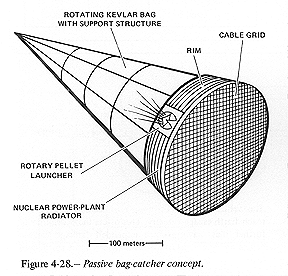
PASSIVE CATCHERS
Two different designs for passive catchers, although rejected for the baseline, were considered in some detail. Figure 4-28 illustrates one version of a passive catcher.
Figure4-28

A second version of a passive catcher is a circular disk, 10,000 m^2 in area, of crushable material such as rigid foam or bonded, glass wool boards. A payload would penetrate this material dissipating its energy and lodging in the material from which it could be retrieved at a later time. Theoretical analysis shows that a typical payload would penetrate about 1.3 m into FR type polystyrene foam (density of 28.4 kg/m^3). The foam catcher could be foamed in place. After collecting for a period of time it could be melted down with a solar furnace; the desired material extracted; and the catcher refoamed in space. It has the advantage of being very simple in conception, but its 500 t of mass is a disadvantage, as is the fact that, at least initially, the plastics for making the catcher would have to come from Earth. Eventually it would be possible to use mostly lunar materials such as bonded glass wool. Like the other passive catcher, the foam catcher requires very high precision in the launchings.